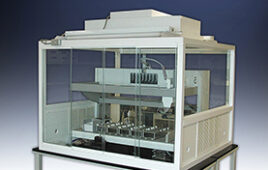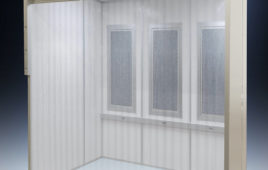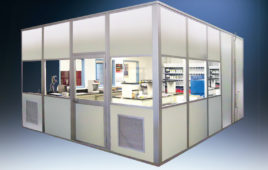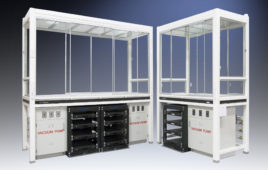We recently participated in an incredibly informative and thoughtprovoking workshop about additive manufacturing (AM), frequently referred to as 3D printing.1 The program was planned as an interactive discussion; many of the participants and attendees had friendly, productive chats with FDA personnel. Really! The workshop was sponsored by the Center for Devices and Radiological Health (CDRH), which is the section of FDA that has jurisdiction for regulation of medical devices. The stated purpose of the workshop was to provide technical input to FDA personnel about technical assessments related to AM, and to foster a transparent process for future AM medical device submissions. While the program was focused on medical device manufacture, there was a strong representation from aerospace. This should not be surprising since many of the issues inherent in 3D printing are common to the manufacture of all high value products. Some of these issues relate to critical cleaning, contamination control, surface quality, materials characterization, and materials compatibility.
It was impressive to observe the range of additive manufacturing that already occurs. Broadly speaking, participants described objects made of metal, of polymers, and even of cells. By using cells in what amounts to an ink jet printer, tissue and even artificial organs made of more than one cell are possible. In terms of metals and polymers, 3D printing of implantable devices shows great promise in terms of customization and response to acute trauma. Of course, implanted devices require particular attention to detail in terms of design, risk assessment, process design, and ongoing monitoring. Also, in the hospital, CT or MRI imaging followed by 3D printing can also be used to obtain models of organs, including damage or defects. Surgeons may find it helpful to simultaneously touch and visually inspect a model of the organ prior to surgery.
Interaction and reaction
In addition to prepared PowerPoint presentations, an unusually high proportion of the program was devoted to questions, answers, comments, and concerns. The program was webcast; comments were taken from those in the room and online. Video documentation and conference materials are available online.2 Many participants discussed the desirability of AM and the need to encourage development of the technique. As might be expected with such audience participation, there were differences of opinion and spirited exchanges. One example of differing opinions relates to the batch to batch consistency of polymers.
Some participants felt that consistency has been achieved; others found it to be a problem. The concept of “consistency” is somewhat like the concept of “how clean is clean.” The concepts of consistent and clean are inherently related to performance requirements. It is well known that successes are published; however, people tend to soft-pedal failure, or report failures anecdotally. Therefore, one approach may be to encourage publication of failures, of situations where inconsistency is found, and of defining such inconsistencies in the context of the application. It may be that we need to define additional requirements. A related approach to resolve the issue may be to establish additional standards or test methods to demonstrate such consistency. We do not have all of the answers, but the workshop was certainly a step in the right direction.
Mindfulness
How does one decide how clean is clean enough? How do you demonstrate cleanliness? What extraction techniques ought to be used? In some of our verbal comments during the workshop, we explained that the issues raised by the prospect of 3D printing are not new. Instead, they are brought into a fresh focus by the prospect of devices and components that can be essentially all surface—devices that may have a very high complexity of configuration, and products that may be comprised of blends of metals and polymers that historically were not available before. We proposed the concept of mindfulness. Not the mindfulness associated with meditation or yoga but rather the mindfulness associated with a healthy respect for the number of variables involved. This is closer to the way that that many in the life-sciences approach their work. Some factors include considering the likely risks, balancing cleaning with the potential for surface damage, providing the rationale for decisions made, and demonstrating ongoing process control.
One example of where we are all likely to have to come to a rational, mindful approach is in minimizing the level of particulates on the surface. Let us suppose you are manufacturing a complex, convoluted part produced by 3D printing using metal powder. Add the likely complication that post-printing processing is also required for final assembly. To determine the level of particles remaining on the surface, you should do extractive analysis. Particles are held in place by both physical and chemical forces, so the way one does the extraction determines what particles
are detected. As with cleaning, the extraction process depends not only on the chemical but also the temperature, force, and time.3 In our experience, with a given extraction protocol, changing the chemical typically allows us to dislodge and extract different populations of particles. And, in our experience, the level of particles will not reach zero. Particularly with complex parts that are mostly surface, there is the danger that as we continue to exhaustively extract particles from the part, we will be extracting “the part from the part.” At some point, we need to make a mindful, rational judgment call.
Controlled environments
What is the future of cleanrooms and controlled environments in a world of 3D printing? In recent columns, we have been exploring what the technical and manufacturing world might look like by the year 2020. AM is happening now and it seems unlikely that we will have to wait five years to see major paradigm shifts. If we envision a 3D printer in every medical office, if there could be additive departments in every hospital, there could be a revolution in fabrication and assembly. Controlled environments and minienvironments could become commonplace. Critical cleaning steps might be conducted in a system where cleaning and cleanliness monitoring occur concomitantly. The entire manufacture might occur in a series of mini-environments.
Interactive discussion
Many questions and issues were raised at the workshop. A summary of some primary issues is available,4 including questions related to final cleaning and sterilization. Cleaning issues relate to removal of particles, including unfused particles, removal of soils that might be
entrapped during post-printing fabrication, and demonstration of cleanliness. A number of sterilization issues were raised including adapting classic sterilization methods and sterility testing as well as the impact of sterilization on device performance. While we have commented that cleaning and sterilization are not synonymous (sterile dirt can be deleterious to device performance), there are areas of commonality, including difficulties presented by complex devices containing hard to reach interior surfaces. Our suspicion is that the interactive discussion may continue; and it probably ought to continue. While the deadline for submission of comments to the FDA docket has passed, it is still possible to provide feedback, including questions, comments and concerns, to the FDA’s Additive Manufacturing Working Group.5
References
1. “Additive Manufacturing of Medical Devices: An Interactive Discussion on the Technical Considerations of 3D Printing,” Oct. 8-9, 2014, FDA White Oak Campus, Silver Spring, Md.
2. Written workshop materials and video documentation; http://www.fda.gov/MedicalDevices/NewsEvents/WorkshopsConferences/ucm397324.htm
3. B. Kanegsberg and E. Kanegsberg, “The Right Extraction,” Controlled Environments Magazine, April 2009. http://www.cemag.us/articles/2009/04/right-extraction
4. Questions Prepared for and Derived from the FDA Additive Manufacturing Workshop http://www.fda.gov/downloads/MedicalDevices/NewsEvents/WorkshopsConferences/UCM421656.pdf
5. FDA’s Additive Manufacturing Working Group; [email protected]
Barbara Kanegsberg and Ed Kanegsberg (the Cleaning Lady and the Rocket Scientist) are experienced consultants and educators in critical and precision cleaning, surface preparation, and contamination control. Their diverse projects include medical device manufacturing, microelectronics, optics, and aerospace. Contact: [email protected]
This article appeared in the January/February 2015 issue of Controlled Environments.




